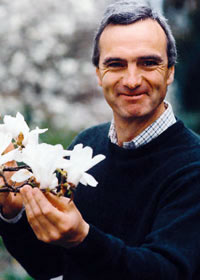Keith Wiley was the head gardener for The Garden House in Devon, England for over 25 years where he developed a style of gardening based on modifying natural landscapes from around the globe. He has also written two notable books: On the Wild Side: Experiments in New Naturalism and Shade: Ideas and Inspiration for Shady Gardens. Keith will be speaking at this year’s Perennial Plant Conference as well as our 2008 Fall Festival. I chatted with Keith earlier this week and thought I’d share with you some of his words on gardening.
EH: In Dan Hinkley’s forward to your book On the Wild Side: Experiments in New Naturalism, he suggests that the theme of your book was inspired by the likes of Thoreau, Leopold, and Huxley. These are some of my heroes and I was so excited to read a book about gardening that challenges horticulturists to see the beauty in the “wild” world around us. Who were your greatest inspirations in the creation of the book as well as the Garden House in Devon?
KW: It has always been natural landscapes and plant groupings and not people that have been my inspiration. How to interpret and then modify them for my own garden conditions and climate is plenty enough of a challenge for me. That deep-seated excitement many of us experience when we look upon a glorious landscape or carpet of wildflowers is what I try to capture back in my garden. The different style of gardening that emerged from this required a completely different set of creative parameters and maintenance regimes. It was with the hope that a few more people might experience this joy and the freedom to express themselves without the shackles of horticultural history weighing heavily on their shoulders that I wrote the book.
EH: Do you agree that gardeners have a certain amount of responsibility to learn from and begin to imitate our natural systems? Many are beginning to believe that it will be our gardens that will save our biodiversity crisis and it will be gardeners who will lead the movement towards bringing “nature” back to overdeveloped areas. Do you agree?
KW: A significant part of my obsession with looking to natural landscapes for our gardening inspiration lies in the fact that to truly understand these areas we must look carefully and in my experience, the more we look, the more we appreciate the beauty in front of us. As a result we are then more likely to try and preserve or protect these fast disappearing treasures. “It’s only gardening Keith, it’s not rocket science” someone once told me, but to me he was so wide of the mark. Gardening when nature is your inspiration is a fusion of art, conservation and environmental awareness where you work in harmony with nature rather than try to have dominion over it. This requires tolerance and a fundamentally different approach to the old traditional ways of gardening and can have ramifications on your whole approach to life itself.
EH: In your book Shade: Ideas and Inspiration for Shady Gardens, you not only teach about what is great about shade gardens, but you actually convince the reader that a garden without shade just hasn’t reached its fullest potential. For you, what is the best quality that a shady garden can bring to a piece of land?
KW: In a word, variety. Variety to the range of plants one can grow and variety to the gardeners themselves. An all sunny garden or an all shady garden can never be a complete garden for me and you really need both. Imagine for a moment a very hot summer day and the feeling one gets from walking into a shady spot in your garden. How can I say more other than perhaps also adding a second word, variety and pleasure.
Be sure to join Keith Wiley and the Scott Associates at the 2008 Fall Festival. Both of Keith’s books are also available at the Scott Horticultural Library! You can also read an article on his unique style of gardening in issue 140 of Gardens Illustrated in the Scott Horticultural library .

